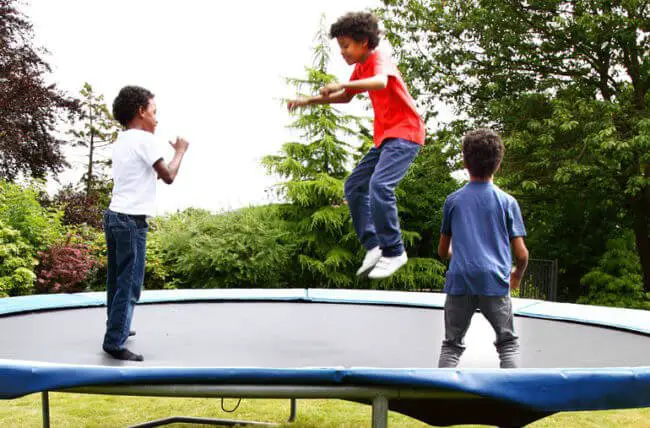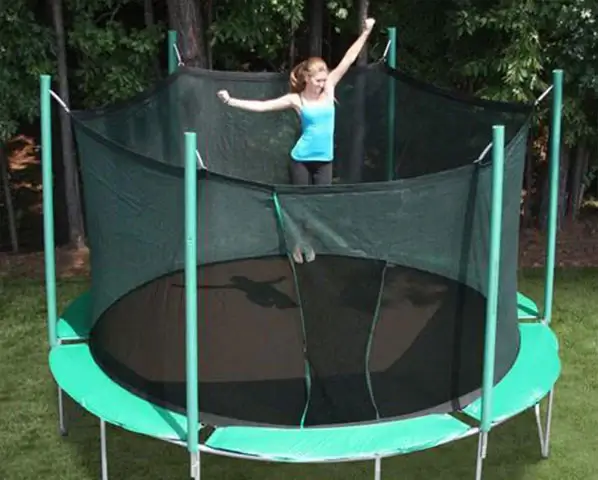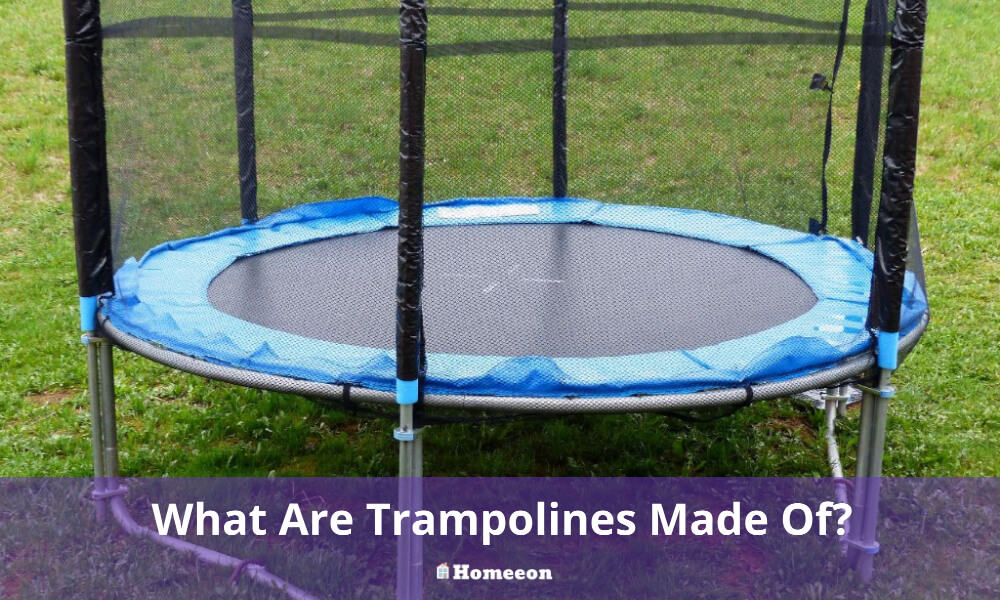Last Updated on August 15, 2023 By Emma W. Thomas
Trampolines are constructed using materials like a strong steel frame, durable polypropylene or nylon jumping surface, and coiled springs for bounce. The frame’s galvanized steel offers sturdiness. High-quality trampolines use UV-resistant materials for longevity. These components combine for a safe and enjoyable jumping experience.
Main Components of a Trampoline

Trampolines are fantastic and addictive recreational devices with soft surfaces that allow for natural and smooth bouncing. Most people use trampolines to help them relax and have a good time, but they do not know how it works.
The main parts of this recreational equipment which make them bounce with much ease include;
- Jumping Mat
The jumping mat is an essential part of the trampoline that is mostly made from nylon material or polypropylene. This part accommodates the user’s weight when one is jumping and landing. The tool is not responsible for the bouncing effect, but it creates a sturdy and robust landing area.
The mat is usually tied to the frame to let the user bounce up and down without falling. If you are looking for a device to use on a large scale, look for a reasonably large one made from well-knit polyethylene or nylon fibers.
Use smooth and soft jumping material to protect the user from injury since the fun in trampolines comes from regularly jumping on the surface. After cutting the polypropylene fabric into the right size, it is then interlocked thermally to make it smoother and ensure that your kids and other users can jump for longer periods without being injured.
2. Springs
Springs are among the most crucial parts of a trampoline as they enable you to bounce up and down the device. High-quality trampolines generally have many springs that are strategically placed between the mat and the frame. There are, however, some spring-less brands that rely on elastic bands.
Elastic bands produce a similar bouncing effect to springs, but they are less durable since they lose elasticity over time. Trampolines have springs made from rust-resistant steel that is generally galvanized for enhanced durability and strength.
Rust-resistant steel boosts the usability and durability of the recreational device as it can be left outside without worrying about rain or humid conditions. If you want to replace your springs, go for those with long coils to allow for superior recoil, unlike short coil springs. The size, quality, and shape also determine the efficiency of the trampoline springs. Tapered springs are preferable since they provide you with added lateral stability while on the trampoline.
Trampolines with several long, tapered springs produce a pleasurable and long-lasting bouncing effect.
3. Safety Nets
Safety pads in a trampoline play a significant role in preventing injuries. The cushions are generally placed on the frame and springs as well, and they use plush-foam-filled vinyl covers. There are different densities of foam depending on the use, type, and manufacturer of a trampoline.
Safety pads soften the impact when landing and allow for a smooth landing and bouncing within the trampoline surface. High-density pads are preferable when dealing with devices with durable, sturdy frames that are suitable for large-scale use. Although foams are not a must-have in trampolines, you can invest in high-density ones to guarantee safety while using them in case you land on the springs or frame.
Safety nets are also vital in making trampolines safer, especially for kids, since they can easily land outside the carpet. They are made of polypropylene, polyester, or polyethylene, but polyethylene is preferred since they withstand the power and have superior density.
4. Frame
Like springs, the frame is made from galvanized steel that is rust-resistant to allow you to use the device even during humid conditions or in the rain. The device can disappoint you if it doesn’t have a proper frame, especially when supporting many users.
The border allows for the tactical suspension of springs to provide a smooth, bouncy surface. It is usually meant to outlast the springs and jumping mat. Check on the frame to ensure that it is firm and ready for use all the time. Inspect the ground surface always to ensure that strands are in good shape and well-positioned.
Are trampolines risky for your body?
Trampoline jumping may pose high risks of injury, especially for children. This recreational activity can lead to fractures and sprains in your legs, arms, neck, or head. Due to the high risk of injury, the American Academy of Pediatrics discourages people from using trampolines.
Safety rules for using trampolines at home

To prevent trampoline injuries for your children or other users, you need to observe the following safety rules;
- Use safety pads and nets
If you want to use home trampolines, set up an enclosure which is a unique net designed to border the device. Cover the springs, frame, and enclose landing surfaces with safety pads and frequently check the equipment for detachments, tears, and deterioration.
2. Place the equipment at ground level.
Ensure that the trampoline is set at ground level and also a safe distance from hazards such as trees.
3. Control trampoline activities
Limit trampoline activities for your kids and don’t allow children younger than six years to use the equipment. Only one person should be allowed to use the trampoline at a time and bar them from potentially risky moves such as somersaults without supervision.
Your children should follow instructions accurately and use protective gear such as a harness
4. Prevent unsupervised jumping
Remove the trampoline ladder if you use one and when not in use to prevent children from accessing the device without supervision.
Always ensure that you actively enforce safety precautions to minimize or eliminate trampoline injuries.
What is a Trampoline Used for?
1. Recreational Activity
Trampolines are widely used for fun and recreation. They provide a thrilling experience as one can jump higher and perform different flips or tricks while bouncing.
2. Fitness and Exercise
Trampolines are increasingly being used for physical exercises. Trampoline jumping, also known as rebounding, is a low-impact activity that strengthens muscles, improves coordination, and enhances cardiovascular fitness.
| Exercise Type | Benefits |
|---|---|
| Cardio Exercise | Improves Cardiovascular health |
| Strength Training | Improves muscle tone and strength |
| Coordination Exercise | Improves balance and agility |
3. Competitive Sports
In the realm of competitive sports, trampolining is recognized by the International Gymnastics Federation. Athletes perform acrobatics while bouncing on a trampoline, judged on the types of skills performed and execution.
4. Therapy and Rehabilitation
Trampolines can also be used as a tool for physical therapy and rehabilitation. The low-impact, repetitive bouncing motion helps increase lymphatic flow in the body and promotes joint and bone health. This can aid recovery following an injury or surgery.
5. Air Training
In specific professional circles such as those of the aerialists, gymnasts, and divers, trampolines are used to train for air awareness. This helps them practice control over their bodies when they are in the air performing jumps and flips.
6. Entertainment Performances
Trampolines are also frequented in various entertainment performances such as those of the circus or acrobatic shows where performers use it to do incredible stunts.
7. Aerospace Training
In the realm of astronaut training, trampolines have been used to simulate different gravitational environments.
Overall, trampolines are versatile tools with a wide range of applications from fitness and sports to therapy and professional training. However, their usage should always be paired with proper safety measures to prevent potential injuries.
Final Word
Trampolines are recreational facilities that are fun to use, especially for leisure. You can use the devices at the park or even at home, but there’s a need to be cautious. Ensure that your equipment has all the essential parts such as springs, frames, jumping mats, and safety pads that are functional. Never allow your kids to use the facility unsupervised or without following all safety rules to avoid injuries.
References:
https://www.rebounderz.com/what-are-trampolines-made-of/
https://plexhiwire.com/blog/what-are-trampolines-made-of/
Emma is a graduate of Domestic Science or Family and Consumer Sciences (Home Economics) from the University of Wisconsin. She has 7 years of experience Working with the strategic section of BestBuy and now writing full-time for Homeeon.
From Managing the Home, Interiors, Cleaning, and Exteriors to Gardening and everything about Making A Home Liveable – is her passion and this Homeeon is the result of this.
Emma loves decorating her home with the best stuff found online. She cares about quality over anything and writes reviews about them here in Homeeon. Get in touch with her over Pinterest.
Keep reading her blogs.

